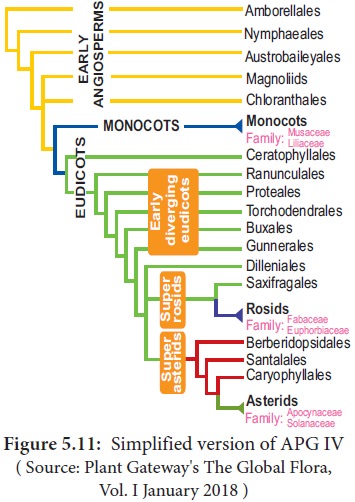Chapter: 11th Botany : Chapter 5 : Taxonomy and Systematic Botany
Angiosperm phylogeny group (APG) classification
Angiosperm phylogeny group (APG) classification
The most recent classification of flowering plants
based on phylogenetic data was set in the last decade of twentieth century. Four versions of
Angiosperm Phylogenetic Group classification (APG I, APG II, APG III & APG
IV) have been published in 1998, 2003, 2009 and 2016 respectively. Each version
supplants the previous version. Recognition of monophyletic group based on the information received from various
disciplines such as gross morphology, anatomy, embryology, palynology,
karyology, phytochemistry and more strongly on molecular data with respect to
DNA sequences of two chloroplast genes (atpB
and rbcL) and one nuclear gene
(nuclear ribosomal 18s DNA).
The most recent updated version, APG IV (2016)
recognised 64 orders and 416families. Of these, 416 families 259 are
represented in India.
The outline of APG IV classification is given
below.

Angiosperms are classified into three clades early
angiosperms, monocots and eudicots. Early angiosperms are classified into 8 orders and 26 families (ANA-grade + magnoliids + Chloranthales)
Amborellales Nymphaeales Austrobaileyales
➢ Seeds
always with two cotyledons.
➢ Presence
of ethereal oils.
➢ Leaves
are always simple net-veined.
➢ Each
floral whorls with many parts.
➢ Perianth
usually spirally arranged or parts in threes.
➢ Stamens
with broad filaments.
➢ Anthers
tetrasporangiate.
➢ Pollen
monosulcate.
➢ Nectaries
are rare.
➢ Carpels
usually free and.
➢ Embryo very small.
Monocots are classified into 11
orders and 77 families (basal monocots + lilioids + commelinids)
➢ Seeds
with single cotyledon.
➢ Primary
root short-lived.
➢ Single
adaxial prophyll.
➢ Ethereal
oils rarely present.
➢ Mostly
herbaceous, absence of vascular cambium.
➢ Vascular
bundles are scattered in the stem.
➢ Leaf
simple with parallel-veined.
➢ Floral
parts usually in threes.
➢ Perianth
often composed of tepals.
➢ Pollen
monosulcate.
➢ Styles
normally hollow and.
➢ Successive
microsporogenesis.
Eudicots are divided into 45 orders and 313
families (early diverging eudicots + super rosids + super asterids).
➢ Seeds
with always two cotyledons.
➢ Nodes
trilacunar with three leaf traces.
➢ Stomata
anomocytic.
➢ Ethereal
oils rarely present.
➢ Woody or
herbaceous plants.
➢ Leaves
simple or compound, usually net-veined.
➢ Flower
parts mostly in twos, fours or fives.
➢ Microsporogenesis
simultaneous.
➢ Style
solid and .
➢ Pollen
tricolpate.
![]()
![]()
![]()
APG system is an evolving system that might undergo
change periodically based on the new sets of data from various disciplines of
Botany. It is the currently accepted system across the world and followed by
all the leading taxonomic institutions and practising taxonomists. However, it
is yet to percolate into the Indian botanical curriculum.

Classification reflects the state of our knowledge
at a given point of time. It will continue to change as we acquire new
information.
Related Topics